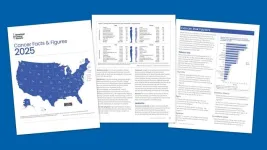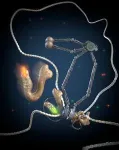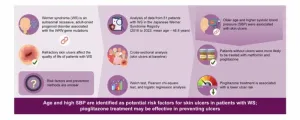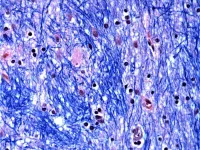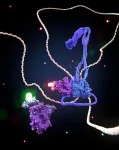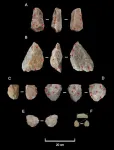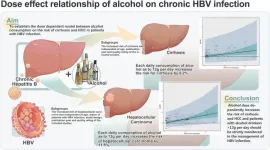(Press-News.org) ATLANTA, January 16, 2025 — The American Cancer Society (ACS) today released Cancer Statistics, 2025, the organization’s annual report on cancer facts and trends. The new findings show the cancer mortality rate declined by 34% from 1991 to 2022 in the United States, averting approximately 4.5 million deaths. However, this steady progress is jeopardized by increasing incidence for many cancer types, especially among women and younger adults, shifting the burden of disease. For example, incidence rates in women 50-64 years of age have surpassed those in men, and rates in women under 50 are now 82% higher than their male counterparts, up from 51% in 2002. This pattern includes lung cancer, which is now higher in women than in men among people younger than 65 years. These important findings are published today in CA: A Cancer Journal for Clinicians, alongside its consumer-friendly companion, Cancer Facts & Figures 2025, available on cancer.org.
“Continued reductions in cancer mortality because of drops in smoking, better treatment, and earlier detection is certainly great news,” said Rebecca Siegel, senior scientific director, surveillance research at the American Cancer Society and lead author of the report. “However, this progress is tempered by rising incidence in young and middle-aged women, who are often the family caregivers, and a shifting cancer burden from men to women, harkening back to the early 1900s when cancer was more common in women.”
Overall, in 2025, there will be an estimated 2,041,910 new cancer diagnoses in the U.S. (5,600 each day) and 618,120 cancer deaths. In addition to projecting the contemporary cancer burden, ACS researchers compiled the most recent findings on population-based cancer occurrence and outcomes using incidence data collected by central cancer registries (through 2021) and mortality data collected by the National Center for Health Statistics (through 2022).
The report also highlights lagging progress against pancreatic cancer, which is the third leading cause of cancer death in the U.S. Both incidence and mortality rates are increasing, and the five-year survival rate is just 8% for the 9 out of 10 people diagnosed with pancreatic exocrine tumors.
“With a critical need to do better, ACS is constantly working to help advance efforts to aid in the discovery of new treatments for cancer patients and care for survivors,” explained Dr. William Dahut, chief scientific officer at the American Cancer Society. “As the largest non-government, non-profit funding source of cancer research in the U.S., we are currently financing more than $450 million in grants to scientists. Our goal is to find answers that help save lives.”
Other highlights from the report include:
Despite overall declines in cancer mortality, death rates are increasing in both men and women for cancers of the oral cavity and pancreas, but just for women for uterine corpus (also known as endometrial) and liver cancers.
Additionally, alarming inequalities in cancer mortality persist, with rates in Native American people 2-3 times higher than White people for kidney, liver, stomach, and cervical cancers. Black people are twice as likely to die of prostate, stomach, and uterine corpus cancers compared to White people and 50% more likely to die from cervical cancer, which is preventable.
Incidence rates continue to climb for common cancers, including breast (female), prostate (steepest increase at 3% per year from 2014-2021), pancreatic, uterine corpus, melanoma (female), liver (female), and oral cancers associated with the human papillomavirus.
The rate of new diagnoses of colorectal cancer in men and women younger than 65 years of age and cervical cancer in women (30-44 years of age) has also increased.
Cancer incidence in children (14 years of age and younger) declined in recent years after decades of increase but continued to rise among adolescents (ages 15-19 years). Mortality rates have dropped by 70% in children and by 63% in adolescents since 1970, largely because of improved treatment for leukemia.
“Progress against cancer continues to be hampered by striking, wide static disparities for many racial and ethnic groups,” said Dr. Ahmedin Jemal, senior vice president, surveillance and health equity science at the American Cancer Society and senior author of the study. “It’s essential to help end discrimination and inequality in cancer care for all populations. Taking this step is vital to closing this persistent gap and moving us closer to ending cancer as we know it, for everyone.”
“This report underscores the need to increase investment in both cancer treatment and care, including equitable screening programs, especially for underserved groups of patients and survivors. Screening programs are a critical component of early detection, and expanding access to these services will save countless lives,” said Dr. Wayne A. I. Frederick, interim chief executive officer of the American Cancer Society and the American Cancer Society Cancer Action Network (ACS CAN). “We also must address these shifts in cancer incidence, mainly among women. A concerted effort between healthcare providers, policymakers and communities needs to be prioritized to assess where and why mortality rates are rising.”
Other ACS authors participating in this study include Tyler Kratzer, Angela Giaquinto, and Dr. Hyuna Sung.
ACS Resources:
Cancer Statistics Center
VOICES of Black Women Study
Cancer Statistics 2024
Breast Cancer Statistics 2024
Asian American, Native Hawaiian & Pacific Islander People Facts & Figures
# # #
About the American Cancer Society
The American Cancer Society is a leading cancer-fighting organization with a vision to end cancer as we know it, for everyone. For more than 110 years, we have been improving the lives of people with cancer and their families as the only organization combating cancer through advocacy, research, and patient support. We are committed to ensuring everyone has an opportunity to prevent, detect, treat, and survive cancer. To learn more, visit cancer.org or call our 24/7 helpline at 1-800-227-2345. Connect with us on Facebook, X, and Instagram.
END
“[…] the results of this study indicate that pioglitazone might be useful in treating refractory skin ulcers, a typical condition that reduces the quality of life of patients with WS.”
BUFFALO, NY- January 16, 2025 – A new research paper was published in Aging (listed by MEDLINE/PubMed as “Aging (Albany NY)” and “Aging-US” by Web of Science) Volume 16, Issue 22 on December 2, 2024, entitled “Less frequent skin ulcers among patients with Werner syndrome treated with pioglitazone: findings from the Japanese Werner Syndrome Registry.”
Scientists ...
Scientists at the Broad Institute of MIT and Harvard, Harvard Medical School, and McLean Hospital have discovered a surprising mechanism by which the inherited genetic mutation known to cause Huntington’s disease leads to the death of brain cells. The findings change the understanding of the fatal neurodegenerative disorder and suggest potential ways to delay or even prevent it.
For 30 years, researchers have known that Huntington’s is caused by an inherited mutation in the Huntingtin (HTT) gene, but they didn’t ...
Scientists from Delft, Vienna, and Lausanne discovered that the protein machines that shape our DNA can switch direction. Until now, researchers believed that these so-called SMC motors that make loops into DNA could move in one direction only. The discovery, which is published in Cell, is key to understanding how these motors shape our genome and regulate our genes.
Connecting DNA
“Sometimes, a cell needs to be quick in changing which genes should be expressed and which ones should be turned off, for example in response to food, alcohol or heat. To turn genes off and on, cells use Structural Maintenance ...
An early human ancestor of our species successfully navigated harsher and more arid terrains for longer in Eastern Africa than previously thought, according to a new study published in Nature Communications Earth & Environment.
Homo erectus, the first of our relatives to have human-like proportions and the first known early human to migrate out of Africa, was the focus of the new study led by the international research team.
The researchers analysed evidence from Engaji Nanyori in Tanzania’s Oldupai Gorge, revealing Homo erectus thrived ...
Homo erectus was able to adapt to and survive in desert-like environments at least 1.2 million years ago, according to a paper published in Communications Earth & Environment. The findings suggest that behavioural adaptations included returning repeatedly over thousands of years to specific rivers and ponds for fresh water, and the development of specialised tools. The authors propose that this capability to adapt may have led to the expansion of H. erectus’ geographic range.
There has been significant debate over ...
About The Study: In this cohort study of Medicaid beneficiaries with schizophrenia, telemental health care diffused rapidly after the onset of the COVID-19 pandemic, particularly in state-operated agencies. Together, agency-level and beneficiary-level race and ethnicity findings suggest within-agency racial and ethnic differences in diffusion of telemental health care. States should monitor the diffusion of innovations across vulnerable populations.
Corresponding Author: To contact the corresponding author, Sharon-Lise Normand, PhD, email sharon@hcp.med.harvard.edu.
Embed this link to provide your readers free access to the full-text article This ...
About The Study: In this serial cross-sectional analysis of people ages 15 to 49 before Dobbs and 1 year after Dobbs, findings suggested that national support for expanded access to medication abortion has grown. Alternative models of care, such as advance provision and over-the-counter, have the potential to offer a promising approach to abortion care, particularly for people living in abortion-restricted states.
Corresponding Author: To contact the corresponding author, M. Antonia Biggs, PhD, email antonia.biggs@ucsf.edu.
To access the embargoed study: Visit ...
Francis Crick Institute press release
Under strict embargo: 16:00hrs GMT Thursday 16 January 2025
Peer reviewed
Observational study
People and cells
Protein level predicts immunotherapy response in bowel cancer
Researchers at the Francis Crick Institute and Barts Cancer Institute, Queen Mary University of London, have shown that the amount of a protein called CD74 can indicate which people with bowel cancer may respond best to immunotherapy.
If integrated into the clinic, testing for this protein could potentially allow hundreds of previously ineligible patients to benefit ...
COLUMBUS, Ohio – Young nearsighted kids who wear bifocal contact lenses that slow uncoordinated eye growth do not lose the benefits of the treatment once they stop wearing the lenses, new research shows.
The study is a follow-up to a clinical trial published in 2020 showing that soft multifocal contact lenses with a heavy dose of added reading power dramatically slowed further progression of myopia in kids as young as 7 years old. Researchers wondered if discontinuing that treatment might cause a rebound of faster-than-normal eye growth that wipes out the benefit.
In the new trial, nearsighted kids wore ...
Background and Aims
The quantitative effects of alcohol consumption on cirrhosis and hepatocellular carcinoma (HCC) in hepatitis B virus (HBV) infection are unknown. This study aimed to establish a dose-dependent model of alcohol consumption on the risks of cirrhosis and HCC.
Methods
PubMed, Embase, the Cochrane Library, Web of Science, and four Chinese databases were searched for studies published from their inception to 15 May 2024. A random-effects model was used to pool the data on the incidence of cirrhosis and HCC, and a dose-dependent model of alcohol’s effect on cirrhosis and HCC was established.
Results
A total of 33,272 HBV patients ...
